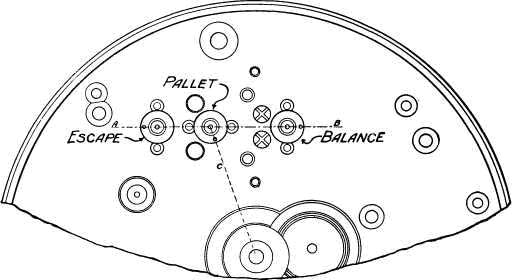Conventional watch cleaning method
After the movement is taken apart, remove the balance jewels, and also the escape and pallet arbor jewels (if these parts are cap jeweled). Before taking these out, however, we should see if the settings of the hole jewels are marked for position. If they are not marked, make a small dot near the edge of each setting so they can be replaced correctly after the cleaning.
The following is the order in which these settings are marked in Waltham movements. In the lower plate they are marked, as shown in pic.

The balance and the escape jewels are on the sides away from the pallet, and the pallet arbor jewel is on the side towards the center of the movement. In the top plate all the jewels are marked on the side towards the center of the movement. After this has been attended to, put all the parts (except the balance) in benzine, to remove oil and greasy matter. After the oil is cleaned off, string a few pieces at a time on a wire loop (see Figure 17), and wash in hot water with a medium soft brush and castile soap. While the parts are on the loop, dip in a solution of cyanide of potassium for three to five seconds. Rinse thoroughly in clean water, immerse in alcohol for about ten seconds, followed by a second rinse in alcohol. Dry in warm boxwood sawdust.
When the mainspring is taken out of the barrel, it should be handled carefully, and no attempt made to straighten it. If the oil on it appears gummy, it should be cleaned off thoroughly with benzine. If the oil is in good condition, it is necessary only to wipe the spring with a piece of cloth by folding it around the spring and sliding it along without straightening the spring. After the spring is put back in the barrel (which should be done with a good mainspring winder), it should be oiled with good quality watch oil in safficient quantity to insure thorough lubrication without risk of spreading on the outside of the barrel.

The escapement jewels, after going through the benzine, should be taken, one at a time, with a pair of specially prepared tweezers, to avoid their snapping off, and held against a flat board, or a large piece of cork, and brushed thoroughly, one side at a time, with a fine toothbrush dipped in alcohol. After the brushing, dip the jewel in clean alcohol, and dry between linen cloths.
After going through this process, we are reasonably sure that the jewels are clean, but to make absolutely sure, we recommend a careful rubbing with a piece of pegwood, which has been pointed so as to go through the holes, and also one which is specially shaped for rubbing the cups in the jewels.
The cleaning of the balance with the hairspring requires special care, as it cannot be brushed safely. The usual method is to put it on a hook and dip it for a few seconds, first in water, then in cyanide; rinse in water, dip in alcohol and dry carefully in sawdust. The balance may be buffed afterwards with a string of chamois skin held in a wire bow, to brighten the rim, as well as the screws.
After the balance has been cleaned, it should be examined carefully for any minute fibre that might have caught in the balance screws, or particles of sawdust in the slots of the screw heads. When cleaning a balance, if the jewel pin is set with shellac, and also when cleaning pallets, care must be taken not to leave them in the alcohol too long, as it would dissolve the shellac and loosen the jewels.
The best kind of alcohol for cleaning watch parts is commercial grain alcohol. We do not recommend using either denatured or wood alcohol for this purpose.
The cyanide solution referred to should be made in the proportion of seven ounces, avoirdupois, to one gallon of water, and this solution should be renewed as soon as it shows a tendency to turn dark. Cyanide of potassium is a virulent poison, and great care must be taken in handling it. It is considered deadly if reaching an open scratch in the skin. The fumes should also be avoided. A good way of keeping both the cyanide and alcohol for cleaning watches is in one gallon specimen or candy jars, with ground glass covers, and marked with conspicuous warning labels.
| « Pocket watch restoration sample | Modern watch cleaning method » |